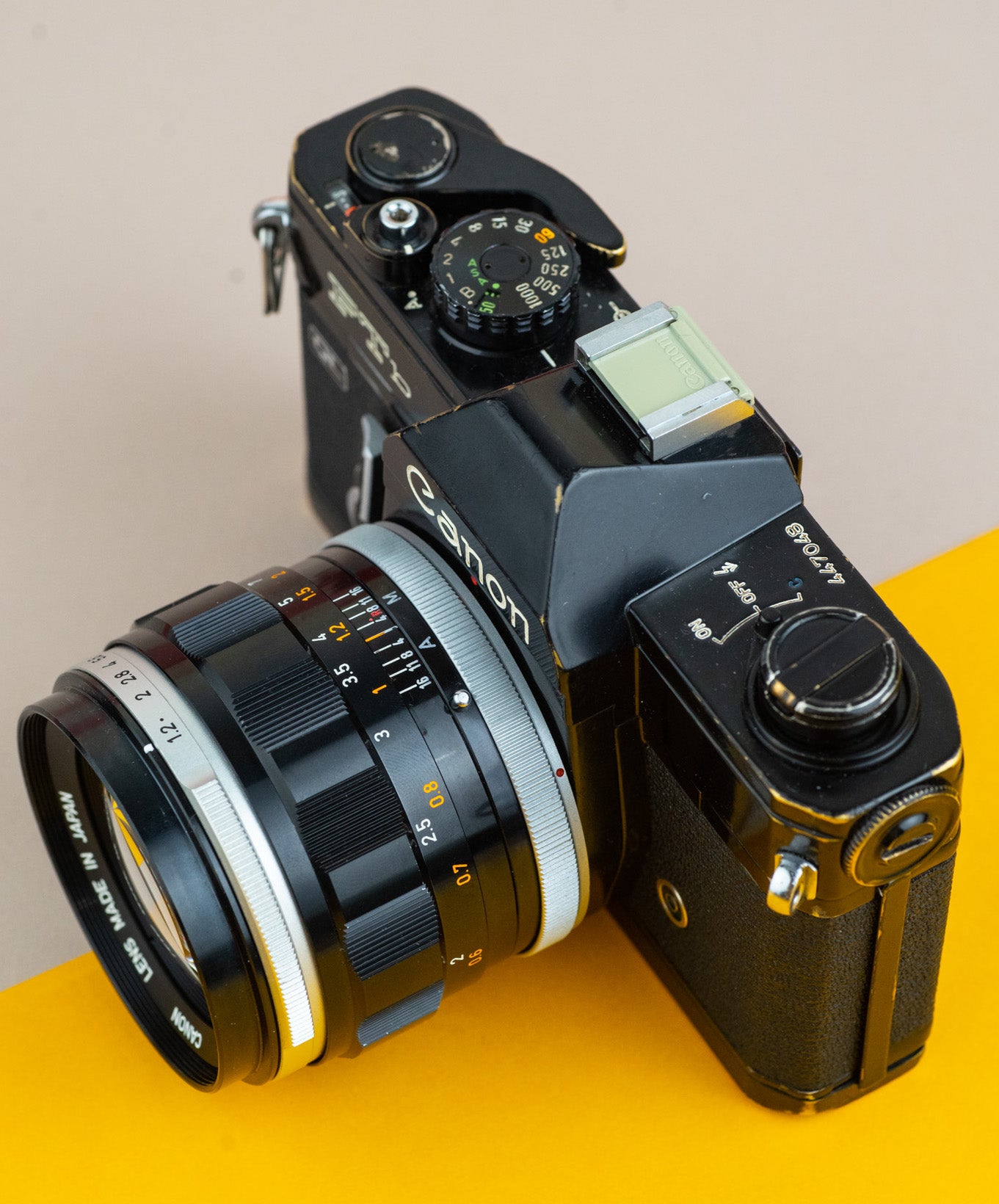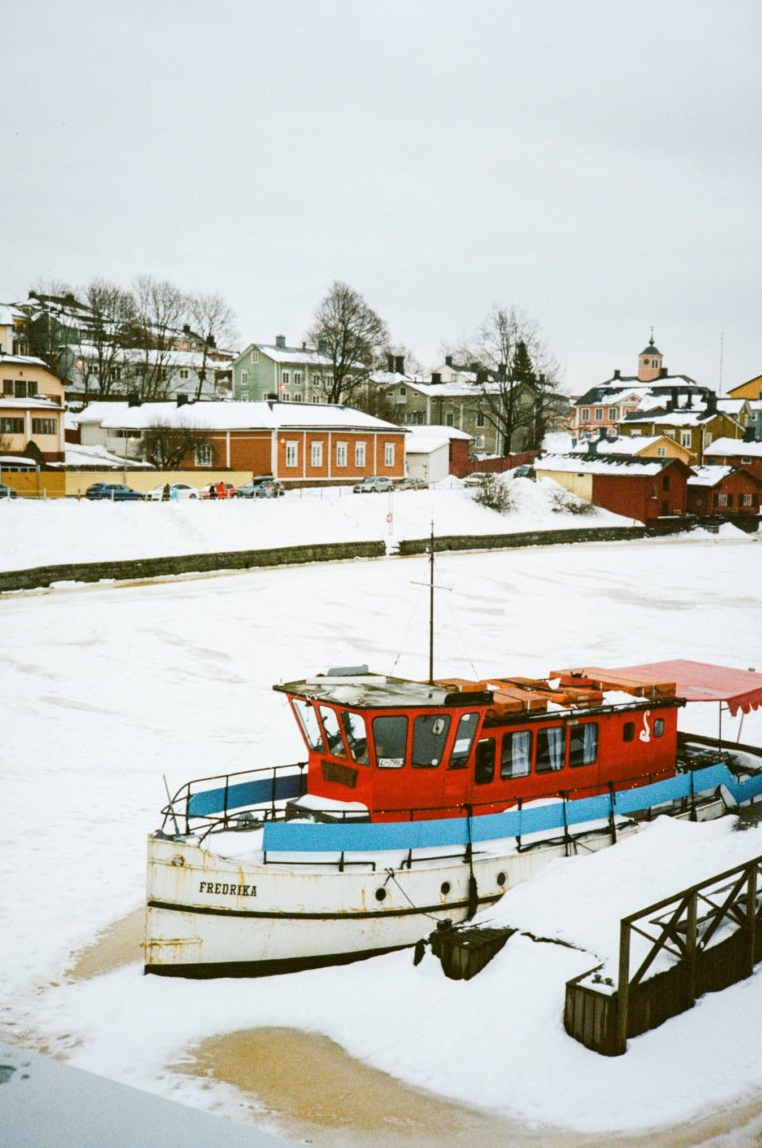Introduction
We see some quite frigid temperatures here in Finland. It can regularly reach -20ºC during the day, which is enough to keep most people inside. But for us, as intrepid analog photographers, this is an opportunity to capture a snowy, icy wonderland on film!
Because of this, we get asked a lot of questions about how to shoot film in cold weather. Apparently there’s a lot of misinformation out there, so I decided to talk with our mechanics and set the record straight on some myths.
Click below to watch the video version, filmed on a frigid -25ºC day in the middle of frozen Näsijarvi! Otherwise, keep scrolling to read the text version!


|
 |
The winter can be one of the most beautiful times of year, so I’ll sprinkle in some winter shots throughout this article to inspire you!
I should mention that our mechanics don’t recommend taking any unserviced camera out in temperatures below 0ºC. If your camera is unserviced, you risk long-term damage to the camera even if it works properly in normal temperatures.
With that out of the way, let’s begin!


|
 |
Mechanical vs. Electronic
First off, let’s settle the difference between mechanical and electronic. For the sake of this article, a mechanical camera does not need batteries to function and an electronic one does. A camera like the Minolta SRT 101 would be considered mechanical because its shutter does not require a battery, even though the light meter does. Got all that? I hope so!
The most common myth spread online is that mechanical cameras are automatically better in the cold than electronic ones. The anti-electronic movement within the film community is loud & powerful but, as usual, incorrect. The problems faced by electronic and mechanical cameras are simply different.
Mechanical cameras will struggle with lubricants freezing and parts shrinking, whereas electronic cameras will struggle with losing battery contact and rapid battery drain.
There are some cameras, mainly cameras released in the 1970s and 80s, that can have both sets of issues. Early electronic cameras like the Minolta XG-1 and Canon AE-1 are good examples of the types of cameras I’m talking about.

Mechanical Camera Issues
As mentioned above, mechanical cameras will struggle with lubricants freezing and parts shrinking when they get into sub-zero temperatures. Despite the assertion by some online that mechanical cameras are indestructible and will work no matter what you throw at them, they require regular maintenance and service to work properly.
Lubrication (The L in CLA) is the most important thing to consider when taking a camera outside. If a camera hasn’t been serviced, the lubricants are likely to be old, dry, and full of dust & debris. These lubricants will freeze, and can trap dirt in delicate parts of the camera.
An important thing the mechanics mentioned is that the cold will expose any flaws that exist in a camera.
For example, I have a Canon F-1 that I haven’t had our mechanics take a look at. On our testing equipment, and in normal temperatures, the F-1 worked perfectly. When I brought it out in -15ºC, though, the mirror started sticking up after about an hour of shooting. The lubricants had frozen.
Once I brought my camera back inside and the temperature normalized, everything was fine. That being said, though, this camera needs to be relubricated or it could face long-term damage.

What Can I Do?
Get your camera serviced, or buy from a store that services their cameras! The only way to avoid malfunction is to buy a camera with fresh lubrication or avoid the cold. Getting your camera serviced, preferably by a technician that knows about cold weather lubricant mixing, is the way to go to keep your camera going in all temperatures.
You can also buy from a store like us! We take great care to make sure our serviced gear is ready to use for a long time, including in the cold. We use special cold-weather lubricants in our mechanical cameras and even do freeze-testing to ensure that our cameras will work in even the most adverse conditions.

Electronic Camera Issues
Electronic cameras are largely misunderstood by the community. These more modern options are largely more capable than their mechanical counterparts. Most electronic cameras with long lists of features that no mechanical camera could ever match.
Yet they’re largely cheaper than mechanical models and have garnered a reputation for unreliability. For most electronic models, especially newer ones, this isn’t necessarily fair.
Electronic cameras run into issues with their batteries in the cold just like any other electronic device. Batteries have to work extra hard in the cold to push out as much power as the device demands, which can cause failure in some cases.
If you look at the manual of your camera, there’s a good chance there will be a recommended operating range written towards the end. The newer the camera, the more likely it is to have this. You’d be surprised what some plasticky autofocus SLRs are rated for!
My Minolta Dynax 5, released in 2001, is rated for -25ºC. That’s an entry level camera! Here are a few more examples of more modern cameras and their temperature ratings.
| Canon EOS-1N | -20ºC |
| Nikon F90 | -10ºC |
| Pentax MZ-5 | -10ºC |
Pretty interesting, right? It’s important to note, though, that all manufacturers noted that batteries begin to slow down in any temperature below 0ºC. That means you may run into issues even if your camera is rated for below 0ºC.
This holds especially true when you consider that even the most modern 35mm SLRs are almost 20 years old. They likely did not receive much service due to the fall of the film industry, either.
Basically, you should temper your expectations a bit from what the manual tells you unless you’ve had the camera serviced.

What Can I Do?
Aside from tempering your expectations like I said, there are a few things you can do to keep your electronic camera alive. Because batteries don’t work as well in low temperatures, the solution is to keep the camera and batteries warm.
While it won’t do much to keep the camera inside your coat, you can hold multiple batteries inside a coat or against your body. Some professional cameras even have external battery packs designed to be worn against the photographer’s body for this exact reason!


|
 |
Handling Tips
When using a camera in the cold, or when going back inside after shooting in the cold, it’s important to take care of your cameras to prevent damage. Let’s go over some common ideas about cold weather camera care!
How do I Avoid Condensation When Moving Back Inside?
When you head back inside after shooting in the cold, the camera (and you) experience a rapid change from cold/dry air to warm/humid air. This sudden change causes condensation to appear in your camera, which can cause damage, including fungus and electrical shorts. Water inside the camera is always not good.
So how can we avoid this? Well, the simple solution is to slow down the transition between cold/dry and warm/wet areas. Putting the camera inside a bag is an excellent way to do this, as it traps the dry air in with the camera and allows it to warm up more slowly.

If you really wanted to keep your camera safe, our mechanics recommended carrying a zip-lock plastic bag around. Storing your camera in one of these when you go back inside is the most effective way to prevent rapid condensation.
You can even put in a small bag of desiccant, like those tiny plastic beads that sometimes come packaged with electronics. Did you know those absorb ambient moisture and are meant to keep the product dry? Pretty neat!
Is it Better to Carry a Camera Inside a Coat to Keep it Warm?
While it may be helpful to keep batteries against your body to keep them warm, keeping your camera inside your jacket prevents you from using it! If you’re going to be taking it out to shoot, you may as well leave it out.
In the worst case scenario, and if you’re very warm, you may actually cause condensation in the camera by taking it in and out of your jacket!

Do the Rules of Exposure Change in the Cold?
No! Film is film no matter the situation, and will capture light the same way in any condition. If you’re using 400 speed film in normal temperatures, then you can expose it at 400 in the cold, too!
One thing worth noting is that snow is very reflective, and may throw off some light meters causing underexposure in the shadows. With flexible films like Kodak UltraMax 400 or Portra 400, this isn’t an issue, but 1-2 stops of exposure compensation should do the trick for more finicky films.

Myth #1 - Having no lubricants is better than having poor quality or old lubricants?
This is incorrect! When you use your camera “dry”, parts grind against each other in ways they weren’t designed to. This can cause damage that requires replacement, which can be expensive or difficult.
While poor quality lubricants cause issues of their own, like freezing and jamming, these issues can mostly be fixed by relubrication. The solution to poor lubrication is fresh lube, not the removal of lubricants entirely.

Myth #2 - Soviet Cameras are excellent in the cold because they were designed for it.
This is also incorrect. Soviet cameras are largely derivative of other designs, especially German ones, and don’t fare better in the cold due to their Russian origin. In fact, many Soviet-era cameras were made with looser machining tolerances than their German counterparts.
The result of these looser tolerances is a camera that is prone to mechanical failure. Soviet cameras have earned their reputation for questionable reliability for a reason and, as I said above, the cold will expose any flaws that exist in a camera.
Another thing that makes Soviet cameras perform poorly in the cold is their poor lubricants. Our mechanics told me that Soviet factories used the absolute lowest quality lubricants available in order to keep production costs low. This leads to cameras that freeze, jam, and malfunction in normal circumstances. Take them in the cold and things will only get worse.

Conclusions
I think the simplest way to explain how cameras act in the cold is what the mechanics said earlier:The cold will expose any flaws that exist in a camera.
Sub-zero temperatures won’t necessarily break your camera, and most can survive a brief excursion into the cold, but if there are issues laying dormant inside the camera the cold will find them. As I mentioned before, even a camera that works perfectly in normal temperatures won’t be immune to the effects of the cold.
That being said, there are a number of easy things you can do to help your cameras last longer and perform better in the cold. The most obvious choice is to buy a serviced camera or have your existing camera repaired by a professional. This will eliminate the need to worry about poor lubrication and will give you the peace of mind that a professional has given your camera their seal of approval.
Keep these tips, tricks, & myths in mind when shooting in the cold and you should have a great time! Now go capture some frigid memories!





